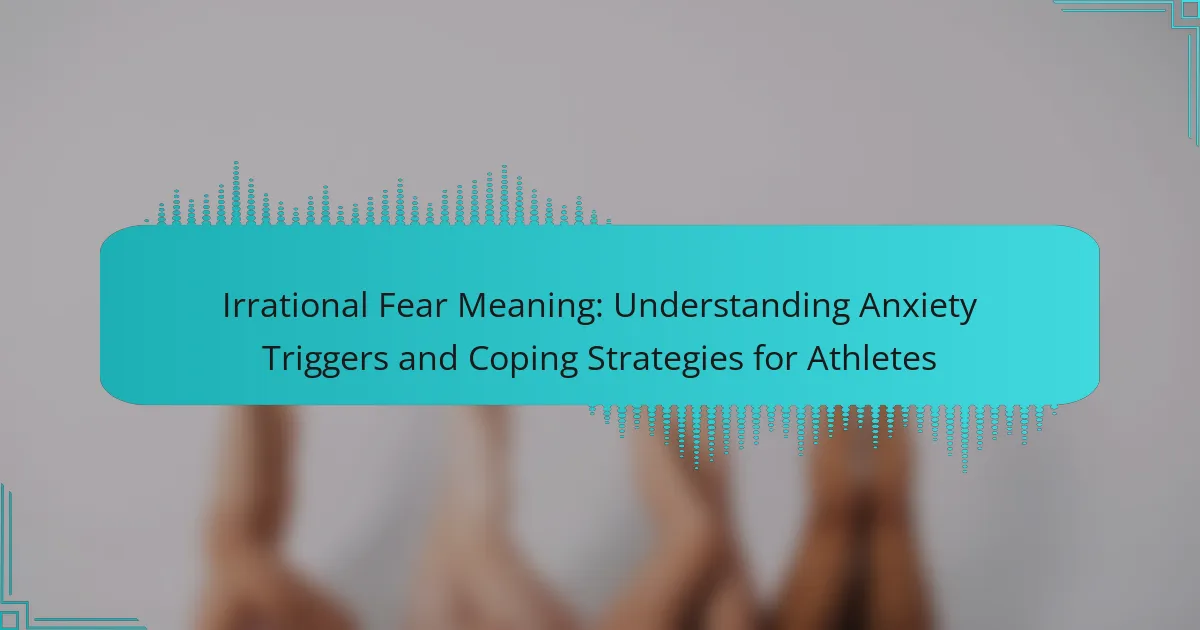Understanding irrational fear is essential for athletes facing anxiety that can hinder their performance. This article explores the triggers of such fears, effective coping strategies like mindfulness and visualization, and unique techniques employed by elite athletes. By addressing these elements, athletes can learn to manage anxiety, enhance focus, and regain confidence in their abilities.

What is Irrational Fear in Athletes?
Irrational fear in athletes refers to intense anxiety that arises from perceived threats, often unrelated to actual danger. This fear can hinder performance and lead to avoidance behaviours. Understanding triggers, such as past experiences or expectations, is crucial. Coping strategies include mindfulness, visualization, and gradual exposure to feared situations. These techniques help athletes manage anxiety and regain confidence in their abilities.
How Does Irrational Fear Manifest in Sports Performance?
Irrational fear can significantly hinder sports performance by triggering anxiety that disrupts focus and confidence. Athletes may experience symptoms like increased heart rate, muscle tension, or negative self-talk. Identifying specific triggers, such as fear of failure or injury, is crucial for developing effective coping strategies. Techniques like visualization, mindfulness, and gradual exposure can help athletes manage these fears, enhancing their overall performance.
What Are Common Anxiety Triggers for Athletes?
Common anxiety triggers for athletes include performance pressure, fear of failure, and competition-related stress. These factors can lead to irrational fears that hinder an athlete’s performance. Performance anxiety often arises from high expectations set by oneself or others, creating a cycle of stress. Fear of failure can stem from past experiences, leading to overthinking and self-doubt. Additionally, the competitive environment itself can amplify anxiety, as athletes compare themselves to peers. Understanding these triggers is essential for developing effective coping strategies, such as visualization techniques and mental conditioning.
How Do Competition and Performance Pressure Influence Anxiety?
Competition and performance pressure significantly increase anxiety levels in athletes. These factors create a heightened sense of expectation and fear of failure, leading to irrational fears. Athletes may experience physical symptoms like increased heart rate and mental blocks, which can hinder performance. Effective coping strategies include visualization techniques and mindfulness practices, which help manage stress and maintain focus. Understanding these triggers is crucial for developing resilience in high-pressure situations.
What Role Does Injury Play in Heightening Fear?
Injury significantly heightens fear in athletes by amplifying anxiety about performance and future risks. This fear can stem from the uncertainty of recovery and the potential for re-injury. Athletes often experience a unique attribute of fear related to their identity and performance expectations, leading to avoidance behaviours. Coping strategies such as mental conditioning and visualization can help mitigate these fears, promoting resilience and confidence in their abilities.

What Are the Universal Coping Strategies for Athletes Facing Anxiety?
Athletes can effectively manage anxiety through universal coping strategies such as mindfulness, visualization, and routine development. Mindfulness techniques help athletes focus on the present, reducing irrational fears. Visualization allows athletes to mentally rehearse successful performances, alleviating anxiety triggers. Establishing a consistent routine creates a sense of control and familiarity, which can mitigate stress responses. Engaging in physical activity and seeking social support further enhance emotional resilience.
How Can Breathing Techniques Help Manage Stress?
Breathing techniques help manage stress by promoting relaxation and reducing anxiety. These techniques, such as deep breathing and diaphragmatic breathing, activate the body’s relaxation response. This process lowers heart rate and blood pressure, creating a sense of calm. Athletes can benefit significantly, as controlled breathing can enhance focus and performance under pressure. Engaging in regular practice of these techniques can lead to improved mental resilience, enabling athletes to cope better with stressors.
What Is the Importance of Mental Visualization in Coping?
Mental visualization is crucial for coping with irrational fears in athletes. It enhances focus, reduces anxiety, and improves performance. By mentally rehearsing scenarios, athletes can confront their triggers and develop effective coping strategies. This technique allows for a unique attribute of transforming fear into confidence, thus facilitating better outcomes in high-pressure situations. As a result, athletes can manage anxiety more effectively, leading to improved mental resilience and overall performance.

What Unique Coping Mechanisms Do Elite Athletes Use?
Elite athletes often employ unique coping mechanisms to manage irrational fears and anxiety triggers. Techniques include visualization, mindfulness, and controlled breathing.
Visualization helps them mentally rehearse performances, reducing anxiety by creating familiarity. Mindfulness practices enhance focus and present-moment awareness, allowing athletes to detach from fear. Controlled breathing regulates physiological responses, calming nerves before competition.
These strategies not only mitigate anxiety but also enhance performance. Research indicates that athletes who utilize such coping mechanisms experience lower stress levels and improved focus during high-pressure situations.
How Do Professional Athletes Leverage Sports Psychology?
Professional athletes leverage sports psychology to manage irrational fears and anxiety, enhancing performance. Techniques include visualization, cognitive restructuring, and mindfulness, which help athletes identify triggers and develop coping strategies. Research shows that mental training can improve focus and resilience, leading to better outcomes in high-pressure situations. Implementing these strategies allows athletes to maintain composure and confidence, ultimately contributing to their success in competitive environments.
What Role Does Team Support Play in Reducing Anxiety?
Team support significantly reduces anxiety by providing emotional reassurance and practical assistance. Athletes often face irrational fears that can hinder performance. A supportive team environment fosters open communication, allowing athletes to express their concerns. This connection can diminish feelings of isolation, which is a root attribute linked to anxiety. Furthermore, teammates can share coping strategies, enhancing resilience. Studies show that athletes with strong team support report lower anxiety levels and improved mental health outcomes. As a result, cultivating a supportive team culture is essential for managing anxiety effectively.

What Are Rare but Effective Strategies for Overcoming Irrational Fear?
To overcome irrational fear, athletes can adopt strategies such as visualization, exposure therapy, and mindfulness techniques. Visualization involves mentally rehearsing success to reduce anxiety. Exposure therapy gradually confronts fears, helping to desensitize the athlete. Mindfulness techniques promote present-moment awareness, reducing the impact of fear. These strategies can effectively mitigate irrational fears and enhance performance.
How Can Exposure Therapy Be Applied in Sports?
Exposure therapy can effectively address athletes’ irrational fears by gradually exposing them to anxiety-inducing situations. This method helps athletes confront and manage their fears, leading to improved performance. For example, a swimmer afraid of competing can start by visualizing the event, then progress to practicing in a controlled environment. Research indicates that consistent exposure can significantly reduce anxiety levels, enhancing overall confidence. Furthermore, this therapeutic approach promotes resilience, allowing athletes to better cope with pressure in competitive scenarios.
What Innovative Technologies Are Athletes Using to Manage Anxiety?
Athletes are increasingly using innovative technologies such as biofeedback devices, virtual reality, and mobile apps to manage anxiety. These tools provide real-time data on physiological responses, simulate high-pressure scenarios, and offer personalized coping strategies.
Biofeedback devices help athletes monitor heart rate and muscle tension, allowing them to develop relaxation techniques. Virtual reality immerses athletes in controlled environments to practice mental resilience and exposure therapy. Mobile apps offer guided meditations and cognitive behavioural therapy exercises tailored to individual needs.
These technologies enhance performance by addressing irrational fears and anxiety triggers effectively. As a result, athletes can focus on their training and competitions with greater confidence.

What Are the Best Practices for Athletes to Manage Irrational Fear?
Athletes can manage irrational fear by implementing specific coping strategies. Techniques such as deep breathing, visualization, and positive self-talk help reduce anxiety. Establishing a routine enhances focus, while seeking support from coaches or sports psychologists provides additional guidance. Regular practice of mindfulness can also enhance emotional regulation.
How Can Regular Mental Health Check-Ins Improve Performance?
Regular mental health check-ins can significantly enhance performance by addressing anxiety triggers. They provide athletes with tools to manage irrational fears, fostering resilience. Regular assessments help identify stressors, allowing for timely coping strategies. This proactive approach enhances focus and reduces performance anxiety, ultimately leading to improved outcomes in competitive settings.
What Common Mistakes Should Athletes Avoid When Coping with Anxiety?
Athletes should avoid common mistakes like ignoring anxiety symptoms, relying solely on avoidance, and neglecting support systems. Recognising triggers is crucial for effective coping. Many athletes underestimate the impact of mental health on performance. Seeking professional help can provide tailored strategies for managing anxiety effectively.
How Can Athletes Create a Personalized Coping Strategy?
Athletes can create a personalized coping strategy by identifying their specific anxiety triggers and developing tailored techniques to address them. First, self-reflection helps athletes recognize irrational fears related to performance. Next, they can explore various coping methods such as mindfulness, visualization, or breathing exercises. Regular practice of these techniques enhances their effectiveness. Additionally, seeking support from coaches or sports psychologists can provide valuable insights and guidance. Finally, athletes should regularly assess and adjust their strategies to ensure they remain effective in managing anxiety.


